What is the AIP (Autoimmune Protocol)?
Autoimmune protocol, autoimmune paleo or AIP for short is an elimination diet designed to heal leaky gut and reduce inflammation with the purpose of reversing symptoms caused by autoimmune disease. It is also used so that one can find out which foods are aggravating their symptoms, causing inflammation and essentially making their autoimmune disease worse. A huge community of autoimmune warriors is sharing their stories and testimonials online, leaving many asking what is the autoimmune protocol? and can I do it too?
Table of Contents
What is an Autoimmune Disease?
Essentially an autoimmune disease is when your immune system attacks healthy cells in your body. Yup, your body is attacking itself. For people with Hashimoto’s, it’s the thyroid, multiple sclerosis the nerves, arthritis the joints, and so on.
There are more than eighty autoimmune diseases, they are notoriously difficult to diagnose, and many people with autoimmunity live with their diseases for decades without getting much help from their doctors. This is why the AIP community is so prolific. Vast, growing, and very active. People in forums, blogs, and communities helping each other navigate this world of healing through diet a lifestyle changes.
How Does The AIP Diet Help?
The autoimmune protocol eliminates specific foods based on their levels of antinutrients and gut permeability. The list of food to exclude seems extensive, but remember, you need to eliminate any and all possible triggers foods. All the foods on the list have the potential to irritate the digestive system, damage the gut, and, when leaky gut is present, even seep through the intestinal wall and trigger inflammation.
Now, let’s not VILIFY any foods. The foods OMITTED are POSSIBLE irritants. We will discuss the details later on. These foods are not bad or good, it’s just science. Pretty much everything we eat has the potential to harm up and heal us. Some more than others. This elimination diet is meant as a baseline, a template for you to work with to find out what works for you.
How can you live symptom-free, pain-free, inflammation-free? Find that sweet spot! Then you can start testing food to add back into your diet.
That’s right, elimination diets aren’t meant to last forever. Even the autoimmune protocol… It’s a TOOL, to learn your trigger foods so you can avoid them, and go on living your life. The more variety of foods in your diet the better!
How to Start The AIP Diet
First, choose your approach. Some folks rip the band-aid off. They go head first, cold turkey. Some folks need to ease into it. I took me several months to do it. I did a Whole30 first. Then I stuck to a paleo template. Eventually, I committed. I got rid of all non-compliant foods. Meal prepped. Bought all the meat and veggies, bone broth etc.
Whichever method you decide… it’s okay. We’re all different. Having information is your greatest tool for success. You will need to prepare all of your meals. Freezer, AIP, meal prepare your new BFF’s.
This company sells and delivers frozen AIP meals, and they are good too!
Digital Resources
Hard Cover Books
- Autoimmune Paleo
- The Healing Kitchen
- The Paleo Approach
- Made Whole (over 100 AIP recipes)
- Made Whole Made Simple (over 90 AIP recipes)
Foods to omit on the AIP
- Coffee (I know, it’s brutal)
- Cacao
- All grains
- All legumes (even green beans, peanuts, soy)
- All nuts
- All seeds
- Seed and Berry based spices (e.g., cumin, peppercorns)
- Eggs
- All dairy (even ghee and butter)
- All nightshades (peppers, eggplants, tomatoes, potatoes—sweet potatoes are fine)
- Processed sugars (honey and maple syrup are fine)
- Artificial sweeteners (even stevia)
- Processed foods (check labels for preservatives and emulsifiers)
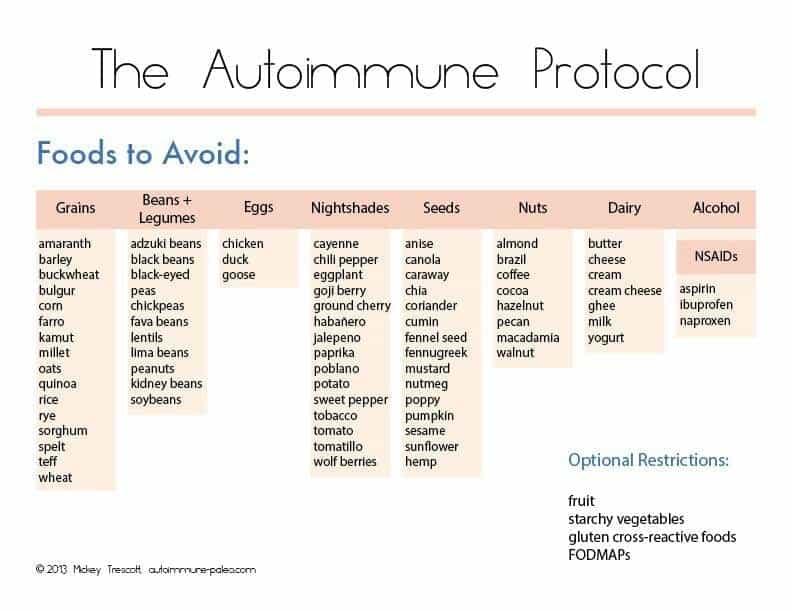
Foods accepted on the AIP
- All animal proteins
- All vegetables and fruits (except nightshades—see the “omit” list)
- Coconut and coconut products (e.g., coconut milk, coconut flour)
- Lard
- Bacon
- Rendered animal fats
- Avocados
- Olive oil
- Salt
- Herbs
Is the AIP Clinically Proven?
The first medical study on it was conducted last year with patients who had inflammatory bowel disease, and 73 percent saw improvement or remission! Here’s what the researchers said: “Clinical remission was achieved by week 6 by 11/15 (73%) of study participants, and all 11 maintained clinical remission during the maintenance phase of the study. [This] rivals … most drug therapies for IBD.”[1]
I understand that seems impossible, it can be stressful, which is why I am a big proponent of choosing your own start method. My biggest piece of advice is to give yourself time. You won’t see results in a few days or even a few weeks. It takes time to reverse leaky gut!
You have to be patient.
You need to keep a detailed food journal. What you ate, when, how you felt. Also, journal any and all symptoms. It’s the only way to map out the correlations and be sure of the foods that could cause issues.
What to Look For?
Short of an autoimmune flare, you know, your autoimmune disease rearing its ugly head… there are some subtle signs a food isn’t jiving…
A headache, runny nose, fatigue, digestive distress, itchy skin, bloating, gas, burping, hives.
Please note… if you’re already sick with a cold, and you have a runny nose, it’s the cold, not the food. If you are super stressed or overworked… the fatigue is probably that, not the food. Don’t go crazy blaming EVERYTHING on food. You have to be honest with yourself about lifestyle factors.
When To Begin Re-Introductions
The rule of thumb is when your flare-free more often than not. Do you feel better? Are you in remission or almost there? It’s really a personal choice. Be honest with yourself. Here is a good resource to help you…
You begin by adding in one food at a time. Consume it for 3 days in a row. First a small amount, then a small serving, then a regular serving. Wait 48 hours. No reaction, you’re good. If you have a reaction, no go.
What are Anti-Nutrients?
Lectins, solanine, saponin: Found in beans, nuts, wheat, and most vegetables with skin and seeds, these antinutrients survive digestion and can penetrate the gut lining.
Gluten: The most difficult-to-digest protein, extremely irritating to the gut.
Tannins: Enzyme inhibitors that prevent the proper digestion of protein.
Oxalates: Found in coffee, sesame seeds, beans, these can interfere with nutrient absorption.
Phytic acid: Found in grains, legumes, nuts, seeds, and coconut, this can interfere with the absorption of minerals and inhibits the digestive enzymes that break down starch and proteins.
Antinutrients are found in all plants; however, many foods, like those allowed on the autoimmune protocol, contain lower levels, and the benefits greatly outweigh any possible, harmful effects, after all, we have to eat something!
The good news is that there are many ways to further reduce the anti-nutrient content of foods so even though you may not be able to enjoy nuts or seeds now, perhaps after healing leaky gut you can enjoy them sprouted! Look at how our ancestors prepared foods, sprouting, fermenting, soaking; preparation methods which makes foods much easier to digest!
Other foods like eggs and dairy are omitted because these foods easily permeate the gut lining and hitch a ride on the bloodstream causing all sorts of havoc!
Troubleshooting During the AIP
Are autoimmune protocol compliant foods making your flare? Have you given it at least 3 months and still not seeing results? Here are some other factors to consider….
Insulin Resistance: When your cells no longer respond to the insulin secreted by your pancreas. This can also tax the liver. I think keto is a great tool to improve insulin sensitivity. I have an AIP + Keto Reset. Or my Keto-Paleo cookbook with over 110 AIP recipes.
SIBO: Small Intestine Bacterial Overgrowth. You need to starve the bad bacteria in your gut. Take a probiotic. Avoid starchy foods, fruit, garlic, broccoli, cabbage, asparagus, and leeks (as well as other AIP non-compliant foods).
Low Fodmap: Some folks need to avoid foods high in Fermentable Oligosaccharides, Disaccharides, Monosaccharides, and Polyols. Implementing a Low Fodmap would mean avoiding all onion and garlic, most fruit, cauliflower, cassava, celery, taro, juices, fermented foods!
Candida: If you’re suffering from thrush or yeast overgrowth you need to avoid sugars and foods with naturally occurring yeast. On top of the AIP, avoid fruits, sweeteners, berries, pork, and tuna. Be wary of vinegar, kombucha, and other fermented foods.
You may talk to your healthcare practitioner or research and deduce that you may have one of these or any of these issues going on, along with your autoimmunity. Combining the appropriate protocols, the autoimmune protocol ++ is what I like to call it, can be tough as hell, but also very useful. Remember… it’s not meant to last forever!
Closing Thoughts
Elimination diets, healing diets, and protocols are my jam. I have done several and constantly experiment with them as my body heals. I have also been at this for 3 years and while I have seen great improvement I am not done. I still can’t eat a lot of things… and I am okay with that. Remember to also work on the emotional side of healing. Do not resent your body, hate it, or be angry with it. You need to practice self-love, grace, and appreciation for the knowledge and tools at your disposal as you go forward to heal yourself.
Related Posts:
[1] G. Konijeti et al., “Efficacy of the Autoimmune Protocol Diet for Inflammatory Bowel Disease,” Inflammatory Bowel Diseases 23, no. 11 (November 2017): 2054–2060.
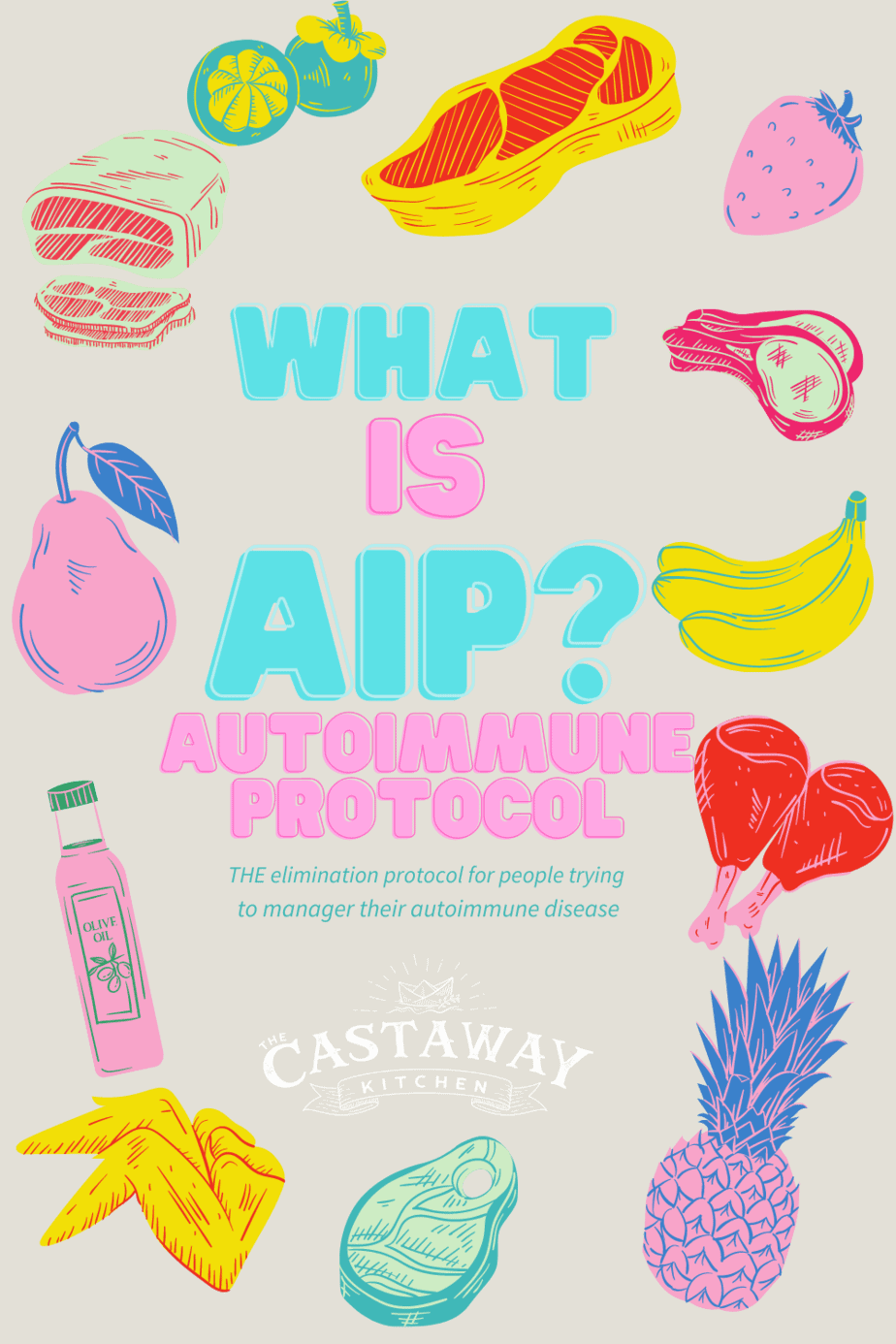
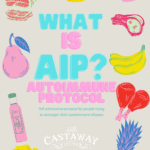
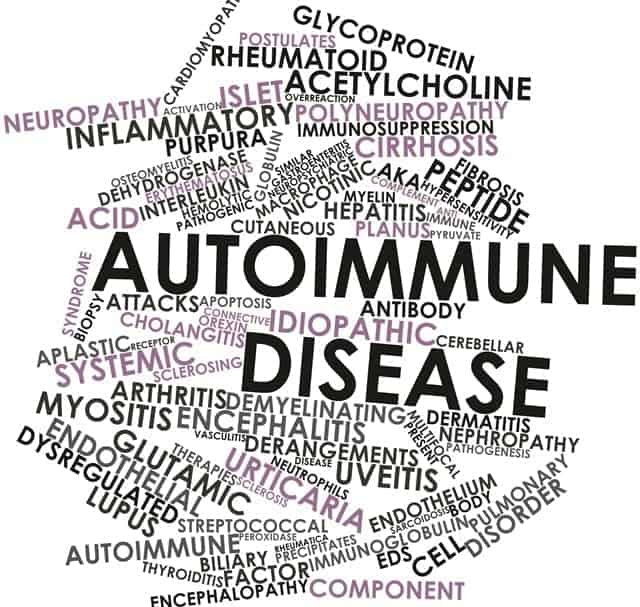
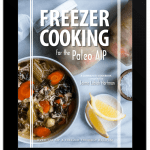
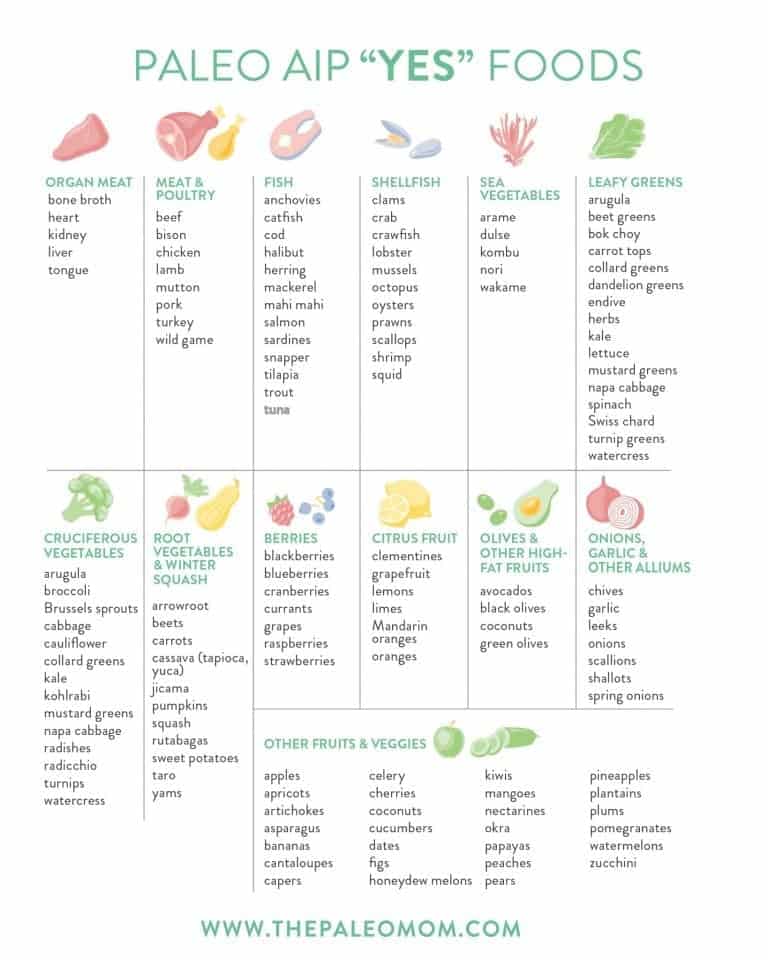
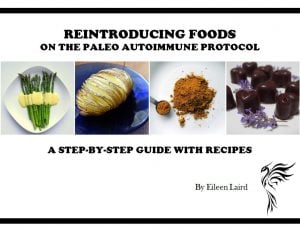

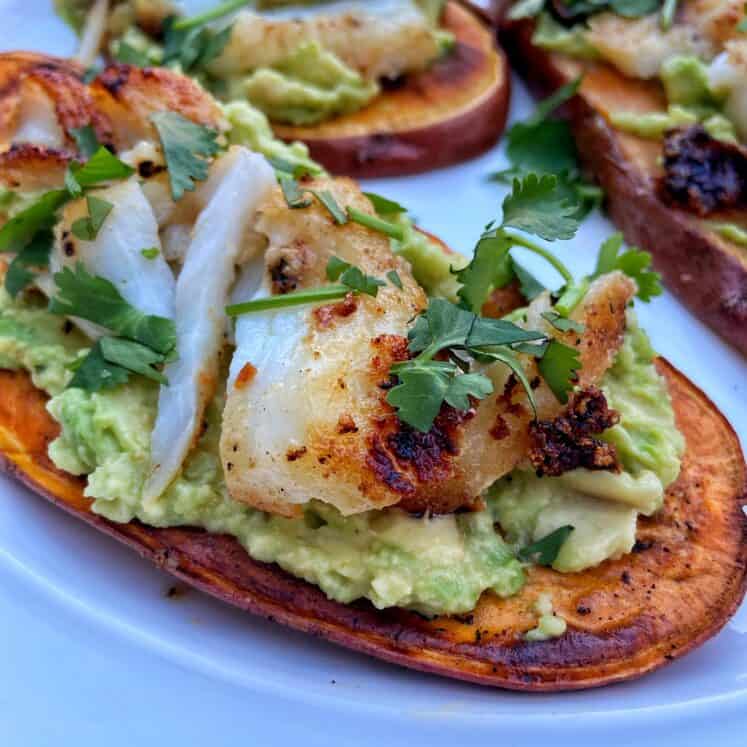


Bounty Lawlar says
Have you seen any success stories of Alopecia Aerta Ophiasis being reversed? Please be candid and honest, as if I attempt this diet it will be an expensive endeavor for me. Currently, I am on a fixed, low-budget. Many foods on the NO-list are inexpensive and b/c of their low-price, staples (pasta, for example). Thank you.
Cristina Curp, FNTP says
I personally have not worked with anyone with alopecia, but there are posts, stories etc online of those who have used AIP to help with it.
https://autoimmunewellness.com/aip-stories-of-recovery-jarretts-recovery-from-primary-sclerosing-cholangitis-and-alopecia/
https://greenbananagirl.com/2017/05/12/your-alopecia-areata-hair-regrowth-plan-part-1/
Amy says
Do you have any suggested reading/Cookbooks/meal plan/prep ideas for a vegan beginning an AIP way of eating?
Cristina says
AIP Vegan isn’t really doable…you would have no protein sources
Barbara C says
Plants are a source of protein, just not animal protein Cristina
Cristina says
Plants have protein, are they a good source of protein? Questionable. On AIP you can’t have beans, nut, seeds, or soy Barbara. Which means all the viable plant sources of protein are out. Essentially Vegan AIP is not recommended. Also, even with let’s day beans, the most popular plant-based protein you only get about 78% digestibility with beans vs 98% digestibility with animal proteins, also no plant sources of protein contain bioavailable B-12.
Anya Lowe says
Thank you for this! I’ve been keto. I lost some weight and shortly after (still keto)the weight is back. I have consistent drainage. That’s my sign something I’m eating isn’t working for my body. Giving up coffee is going to be so sad!!! Butttt whatever it takes to be in a super healthy body! Wish me luck!!
caglanaz says
there is tobacco ın the nıghtshades but it is said “foods to avoıd”. ı didn’t understand smokıng ıs okey or not. pls help me.
Cristina says
Smoking is definitely not okay!
Bryan lowery says
How long can it take for symptoms to reappear because I have been keto over a year and just recently started eating those lavash/Joseph’s pitas and I thought I was in the clear for gluten because it was over a week no signs of gluten flare. But today my ankle hurts and I have my red patches on skin back so I was just wondering if it’s the bread and if it could take that long to reappear. I mean I don’t over eat them but I have had them a few times last week. Could it be a flare type thing and just took a while to kind of build up??
Cristina says
Bryan, absolutely! Many foods take several days to show symptoms, or only affect you when eating a few times. That’s how cheese is with me. One day i’m good. two days, eh…. third day… flare! When you reintroduce foods into your diet it’s important to eat the food once in a small amount, wait 24 hours. Eat it again in a larger amount, wait 24 hours, and then have a large serving and wait a final 24-36 hours… after that 3 DAY PROCESS… you should know for sure.